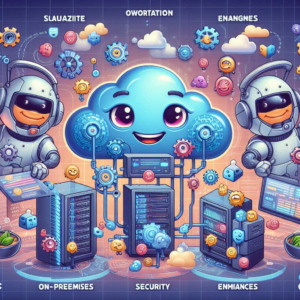1. Introduction to Hybrid Cloud and Multi-Agent Systems in Manufacturing
In the evolving landscape of smart manufacturing, operational complexities continue to rise due to fluctuating production demands and the need for real-time adaptability. Traditional manufacturing systems often struggle to maintain efficiency under these conditions. The hybrid cloud model addresses these challenges by providing scalable, flexible, and secure infrastructure for manufacturing operations. Simultaneously, Multi-Agent Systems (MAS) enhance production efficiency by enabling autonomous agents to collaborate dynamically, optimizing resource allocation. Just as hybrid cloud solutions distribute workloads efficiently across cloud environments, MAS facilitates agile and intelligent manufacturing processes.
2. Key Features of Multi-Agent Systems and Cloud Management Solutions
2.1 Autonomy: Each agent operates independently, making decisions based on its own knowledge and the current state of the environment. This autonomy allows for rapid responses to changes in production conditions without centralized control, akin to effective cloud management solutions that facilitate real-time adjustments across multiple platforms.
2.2 Cooperation: Agents can communicate and negotiate with one another to achieve common goals. This cooperation is essential in complex manufacturing environments, similar to how hybrid cloud strategies enable diverse platforms to work seamlessly together.
2.3 Adaptability: MAS can dynamically adjust to changes in the production environment, such as variations in order types and resource constraints. This adaptability is crucial for maintaining efficiency in smart factories, paralleling the need for continuous integration and deployment in software development.
2.4 Scalability: New agents can be added to the system as needed, allowing for easy scaling of production capabilities. Much like hybrid cloud solutions that facilitate scaling in response to demand fluctuations, MAS enhances operational capacity.
2.5 Autonomy: Each agent operates independently, making real-time decisions based on environmental conditions. Similarly, hybrid cloud solutions enable automated resource management without centralized control.
3. Dynamic Scheduling in Smart Manufacturing and Hybrid Cloud Benefits
Dynamic scheduling is essential in modern manufacturing to handle unpredictable workloads and customization. Unlike static scheduling, dynamic scheduling powered by hybrid cloud and MAS continuously monitors production conditions and adjusts tasks in real time. This approach ensures:
– Optimal resource utilization
– Reduced downtime
– Improved response to market demands
By integrating hybrid cloud solutions, manufacturers can leverage advanced computing resources to enhance scheduling efficiency.
4. The Dynamic Scheduling Process
1. Order Reception – The system receives and decomposes orders into tasks.
2. Task Prioritization – Agents analyze urgency, energy consumption, and resource availability.
3. Negotiation and Bidding – Agents negotiate, ensuring optimal task assignment.
4. Task Execution – Agents complete tasks while monitoring progress.
5. Feedback Loop – Insights are gathered to improve future scheduling decisions.
5. Implementing Multi-Agent Technology for Scheduling and Cloud Management
Successful implementation of MAS and hybrid cloud solutions requires:
– Agent Architecture – Supporting autonomy, negotiation, and role-specific functionalities.
– Communication Protocols – Facilitating seamless collaboration using standards like the Contract Net Protocol (CNP).
– Knowledge Representation – Utilizing data analytics to enhance decision-making.
– Decision-Making Algorithms – Applying techniques such as Particle Swarm Optimization (PSO) for efficiency.
– Monitoring and Adaptation – Ensuring real-time adjustments based on operational insights.
6. Case Study: Energy-Aware Load Balancing in Hybrid Cloud Environments
A real-world example of MAS in dynamic scheduling is the Energy-Aware Load Balancing (ELB) system in a smart factory. Edge nodes convert machines into intelligent agents capable of self-organization, optimizing task distribution based on:
– Energy consumption – Prioritizing low-energy-intensive tasks.
– Urgency levels – Assigning tasks based on customer requirements.
– Workload balancing – Ensuring even task distribution across agents.
With the integration of hybrid cloud, real-time data processing allows continuous optimization, leading to lower energy consumption and higher productivity.
7. Challenges and Future Directions in Multi-Agent Technology and Hybrid Cloud Solutions
Despite their advantages, MAS and hybrid cloud adoption in manufacturing face challenges:
1. Complex coordination – As the number of agents grows, communication and decision-making become intricate, requiring robust protocols.
2. Data management – Accurate and timely information is crucial for MAS efficiency, just as hybrid cloud requires well-structured data governance.
3. System integration – Many manufacturers rely on legacy systems, posing challenges for MAS and hybrid cloud implementation.
4. Security concerns – Increased connectivity raises risks, emphasizing the need for hybrid cloud security measures to protect sensitive data.
Conclusion
The integration of hybrid cloud architecture with Multi-Agent Systems is transforming smart manufacturing by enabling efficient resource allocation, real-time adaptability, and seamless scalability. By leveraging these technologies, manufacturers can overcome traditional scheduling inefficiencies while reducing operational costs and energy consumption.
Future advancements in Hybrid Cloud Architecture and Security Considerations will further enhance the reliability and performance of manufacturing systems. As industries adopt AI-driven analytics and Industrial IoT (IIoT), the synergy between hybrid cloud and MAS will play a pivotal role in shaping the future of smart manufacturing.
Do you like to read more educational content? Read our blogs at Cloudastra Technologies or contact us for business enquiry at Cloudastra Contact Us.
